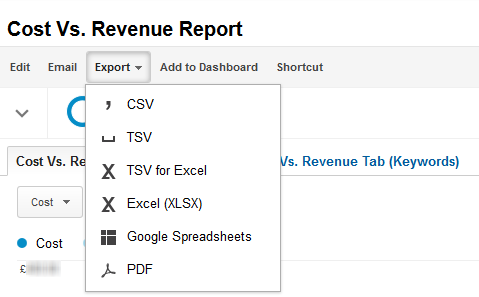Last year Google finally added cost data information from Google Adwords into Google Analytics. Combining this along with ecommerce tracking allows you now to see extremely useful cost vs. revenue reports to ensure you are making a profit through your paid ads.
Setting up Ecommerce Tracking for Adwords
If you haven’t done so already, you need to take these three steps to ensure you can track ad costs and product revenues for an ecommerce site:
1. Link your Google Adwords account with your Google Analytics account – see this video guide for instructions.
2. Turn ecommerce tracking on within Google Analytics – see Google’s guidelines.
3. Setup the ecommerce tracking script on your final payment page after a successful transaction (this is usually a page called “Thank you for purchasing”, “Success Page”, “Payment Confirmation”, “Order Received”, etc., and is the last page customers see after making a transaction). Many ecommerce platforms have a free module or plugin which can do this for you, such as Fooman Analytics Plus for Magento, or Shopifys’ in-built solution. If you have to set this up manually on a non-common platform then talk to your webmaster about implementing Google’s official code.
You can now hopefully see your Adwords keyword revenue amounts by selecting the Adwords Keywords report under Acquisition reports in Google Analytics.
You can also see your cost data imported into Analytics by looking at the Cost Analysis report, also under Acquisition reports. Click on “google / cpc” to drill down into your campaigns to see where your ad spend is going in general (again select the correct analytics profile in the top left corner).
Setting up a custom report for Adwords Cost vs. Adwords Revenue
The most useful report to have is one that shows ad cost vs. ad revenue, so you can see exactly which campaigns, ad groups or keywords are making a profit and which ones need tweaking or removing. You can have a quick look at cost vs. revenue at a generic campaign level in the Bid Adjustments report, but to create a more detailed custom report, follow these steps:
1. Click on the “Customization” tab at the top of the page and create a “New Custom Report”.
2. You may want to give your report a title so you can come back to it another time.
3. Within “Metric Groups” select “Cost” and “Revenue”
4. Within “Dimension Drilldowns” select “Ad Group”
5. Within “Filters” select “Include” + “Medium” + “Exact” + “cpc”.
6. If you wish, you can use the same report to show paid keyword cost vs. revenue with a new tab, or just overwrite the one you have just created when you have finished looking at the ad group level. Just change the “Dimension Drilldowns” to “Keyword” to show the cost vs. revenue amounts for paid keywords only:
Saving the report will initiate it; once set up you can just click on the “Customization” tab and run all of your saved reports straight away.
From these reports you can see a list of ad groups or keyword along with the Adwords cost and revenue generated from people who clicked your ads within that ad group or from that keyword:
You can visualise ad costs and revenues in the Explorer graph by simply adding “Revenue” where it says “Select a metric” above the graph:
You can select any date range in the top right corner and, if set up, you can switch between keywords and ad groups by selecting the different tabs at the top. Remember that it may take a couple of hours for today’s data to be added into Analytics, and some customers may take a few days to finally make a purchase after an ad click, so it’s best to ignore the current day’s results until the next day.
If you have a whopping number of visitors (over around 200,000) in your report, Google starts to estimate the values. Ensure that the slider in the top right corner is moved to the “Higher Precision” option for most accurate results:
Calculating the profit made from Adwords traffic
Now it’s time to see which ad groups or keywords are creating direct profit, and which ones need immediate attention as they may be spending more than they gain in profits.
If you are familiar with Excel, it’s best to export this report as an Excel spreadsheet and create a formula to highlight the revenue divided by cost relationship. Before you export the data, ensure that you are showing all the data by selecting “show rows” at the bottom of the table and showing more rows than you have got:
You can export the data into many formats using the export tab at the top of the page:
Working out a revenue to profit ratio can be a headache for businesses that don’t have fixed delivery costs, overheads or margins. In this case, you may have to either approximate these values or break down your report into different areas and work on them separately.
Working out a revenue to profit ratio for an example product
Product Cost (wholesale) = £3.30
Product Price (in store) = £9.99
VAT = 20%
Delivery Cost (customer) = FREE
Delivery Cost (actual) = £0.80
Approximate overheads per product sold (staff costs, utility bills, equipment, etc.) = £0.40
To be in profit we need [revenue minus costs] to be a positive number, therefore:
Maximum Ad Spend (per product) < Revenue – Cost
< (9.99 / (1.0 + 0.2)) – 3.3 – 0.8 – 0.4
< £3.83
With this we can work out how many times revenue needs to be above ad spend to turn a profit:
Revenue Per Ad Spend Ratio = Product Price / Maximum Ad Spend (per product)
= 9.99 / 3.83
= 2.61
So in this simplified example the advertiser needs to get 2.61 times the amount of revenue back from what they spend on Adwords in order to turn a profit. If £100 is spent on Adwords, they need to make at least £261 back in revenue to ensure it has been worthwhile paying for the traffic. £261 exact revenue from £100 ad spend would be the break-even point, so any extra revenue would be pure profit.
Some companies may need to get up to around ten times the revenue back from what has been spent on Adwords in order to be profitable. The key is to keep a close eye on the different parts of your Adwords account to see where great profits are being made and where money is being wasted.
Max CPC Adjustments
If a set of keywords is costing you too much in terms of revenue generated then don’t be too hasty to remove it. Remember that customers may spread the word about your brand, buy another product in the future, or may be up-sold further related products or services in the future through a channel such as email marketing. You should also be able to lower your maximum cost-per-clicks to then make the keywords profitable again. You will get fewer clicks overall, but each click is cheaper with a similar conversion rate, resulting in increased profits overall.
Maximum CPC bid adjustments are a whole new topic which we will cover in the near future. In the meantime, bear in mind that you can raise your maximum CPCs to gain extra traffic (with higher placed ads) and make more profits overall, and in some cases even lower your maximum CPCs to gain cheaper clicks but make more profit per sale, and therefore more profit overall. There is a sweet spot where you can make the most profit out of your paid advertising, which hinges on your all-important conversion rate.
Keep a close eye on your Adwords profitability, as it’s very easy for a PPC agency to disguise a badly run PPC account with figures taken from highly converting branded keywords that make the whole account overall look profitable when in fact it’s pouring money down the drain. If your business is named “XYZ shoes” for example, then you will get a very impressive conversion rate when someone types “XYZ shoes” into Google and clicks your advert. When averaged out, this can easily mask a badly run PPC account.
We hope you use this advice to ensure your PPC campaigns are profitable. Let us know your ecommerce tracking tips or queries in the comments below.













